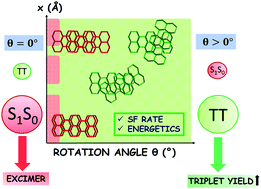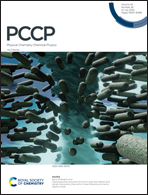Modulating singlet fission through interchromophoric rotation†
Abstract
Singlet fission (SF) is a spin-allowed, exciton-multiplying phenomenon that can be utilized to improve the efficiency of organic solar cells. It is well-understood that SF is sensitive to the local crystal morphology and an appropriately balanced coupling is essential to facilitate efficient SF. In this study, we show how the interchromophoric rotation selectively modulates the interaction between the monomer frontier molecular orbitals, promoting both fast and exothermal SF. We evaluate the effective electronic coupling for SF (VSF), the square of which is proportional to the SF rate, and the effective energies of the Frenkel exciton (FE/S1S0) and triplet pair exciton (TT) in a terrylene dimer model. Optimal interplanar rotation of the chromophoric moieties in slip-stacked arrangements pulls the effective energy of the TT state below that of the FE state. Consequently, SF is favored over competing pathways such as excimer formation, thereby enhancing the overall triplet yield. This work represents a step towards improvising the molecular design guidelines for SF and understanding the importance of interchromophoric rotation over the conventional slip-stacked arrangements for achieving favorable intermolecular electronic coupling towards efficient SF.

- This article is part of the themed collection: #RSCPoster Conference


 Please wait while we load your content...
Please wait while we load your content...